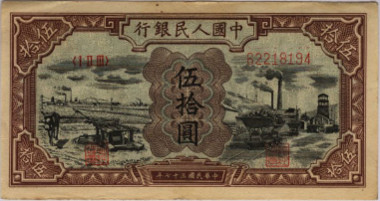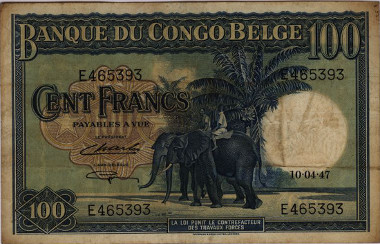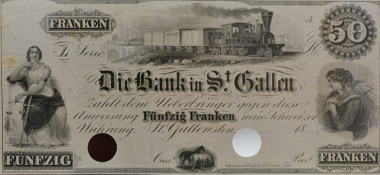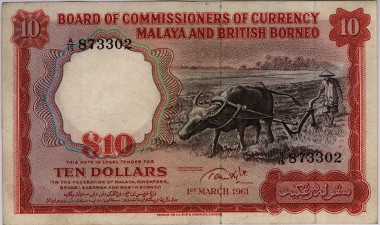February 6, 2014 – From muscle power to steam engines, the new banknote exhibition held by Giesecke & Devrient (G&D) traces the history of industrialization. The in-house museum of the Munich-based technology group and banknote specialist is displaying one hundred banknotes – both historical and current – from 61 countries, vividly documenting the role of ‘Horsepower – From Working Animals to Railroads’ in technical progress on every continent. Visitors are welcome by prior arrangement. Admission is free of charge.
China. 50 Yuan, 1948. On the left a donkey drives a whim in circles. © HVB Stiftung Geldscheinsammlung, München.
‘Banknotes are more than just a payment method. They are also authentic documents of their time,’ stated Dr. Walter Schlebusch, CEO and Chairman of G&D’s Management Board, in his opening speech. ‘Even though machines have largely replaced animals in assisting people with their work, horsepower remains an expression of power output to this day.’
Belgian Congo. 100 Francs, 1946/47. Motif: Elephants with riders. © HVB Stiftung Geldscheinsammlung, München.
The exhibits range from depictions of domesticated wild animals as draft animals and beasts of burden, through equestrian imagery conveying long distances surmounted with the help of horses, to illustrations of the first steam engines. These multiplied the muscle power of animals many times over, heralding the Industrial Age.
Switzerland. 50 Francs, circa 1852. Steam locomotive with coupled wagons, viaduct in background. © HVB Stiftung Geldscheinsammlung, München.
The oldest banknote in this exhibition is a Swiss 50 franc note from 1852. All the banknotes are supplied by HypoVereinsbank’s banknote collecting foundation, HVB Stiftung Geldscheinsammlung – one of the largest collections of its kind worldwide.
Additionally, as a special exhibition, Kazakh artist and banknote designer Mendybay Alin is displaying fourteen oil paintings in the banknote museum’s gallery. The scenes are drawn from his ‘Malta’ series, as well as from Kazakh folklore.
Malaya and British Borneo. 10 Dollars, 1 March 1961. Water buffalo with ard. © HVB Stiftung Geldscheinsammlung, München.
Both exhibitions will run to April 30, 2014, at the G&D banknote museum, which is located in the former main lobby of the company’s Munich headquarters (corner of Prinzregentenstrasse and Vogelweidestrasse). Admission is free of charge. Tours will take place on two afternoons a week (Tuesdays and Thursdays at 1:00 pm or 3:00 pm) by prior arrangement. These can accommodate groups of up to twenty people. Visitors can register between 10:00 am and 12:00 pm on weekdays by calling +49 (0)89 4119-1354. The exhibition is closed on weekends and public holidays.
You will find more information on the exhibition on the website of HVB Stiftung Geldscheinsammlung.
And you should take a look at the very informative website of Giesecke & Devrient.








